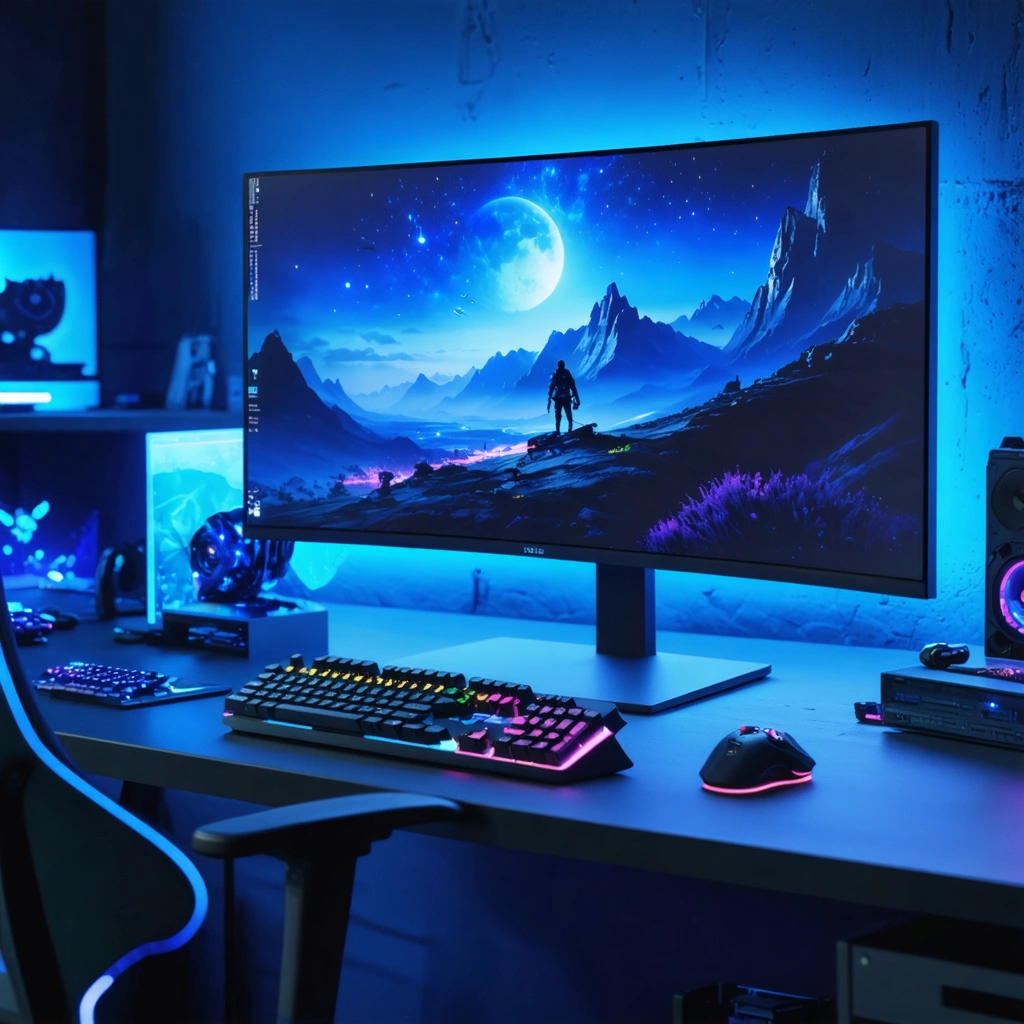
Imagine diving into your favorite game and being instantly enveloped by colors so rich, blacks so deep, and details so crisp that the digital world feels almost tangible. If you’ve ever squinted at a traditional screen, trying to spot that hidden enemy lurking in a shadow or admired a sunset that looked more like a washed-out photo than a breathtaking scene, you know the frustration of less-than-perfect display technology. For gamers, the display isn’t just a window—it’s the entire stage, and every pixel counts.
Standard LCD monitors have been the go-to for years, but they often fall short in delivering the kind of visual fidelity that truly immerses players. Have you noticed how darker scenes sometimes appear grayish instead of pitch black, or how vibrant explosions lose their intensity? This lack of contrast and color depth can rob your gaming experience of its full potential, leaving you less engaged and, frankly, a little disappointed.
Why Conventional Displays Don’t Cut It for Gamers
Let’s be real: gaming has evolved into a visually demanding art form. Modern titles boast jaw-dropping graphics, intricate lighting effects, and ultra-high resolutions. Yet, many gamers still find themselves confined to monitors that can’t keep up. The traditional LCD panel relies on a backlight that’s always on, which means blacks aren’t truly black—they’re just dimmed. This results in a washed-out image where shadows lose their mystery and highlights lack punch.
Even with the rise of 4K monitors, which offer stunning resolution and pixel density, the fundamental limitation of LCD technology remains. A 4K OLED monitor, on the other hand, doesn’t just increase resolution—it completely transforms the visual experience. The difference is like night and day, literally.
What Makes OLED Monitors a Game-Changer?
OLED, or Organic Light Emitting Diode technology, means each pixel lights up independently. This independence allows for true blacks because pixels can switch off entirely when displaying dark scenes. No glow, no haze—just absolute darkness where it’s meant to be. The result? Vibrant colors pop against the inky blackness, creating stunning contrast ratios that make every frame feel alive. Whether it’s the flickering light of a torch in a dungeon or the blazing neon of a futuristic cityscape, an OLED gaming monitor elevates these moments beyond what you thought possible.
And when you combine this with the sharpness of 4K resolution, the 4K OLED monitor doesn’t just show you the game—it invites you to step inside it. Players gain a competitive edge because details in shadows and highlights become clearer, making it easier to spot movement or subtle cues in complex environments.
- True deep blacks enhance shadowy areas
- Vibrant, wide color gamut brings environments to life
- Fast pixel response times reduce blur and ghosting
- Wide viewing angles keep colors consistent from every seat
Getting the Most Out of Your OLED Gaming Monitor
Choosing an oled monitor for gaming isn’t just about picking the flashiest screen—it's about understanding what features maximize your experience. The market now offers several oled monitors designed specifically for gamers, ranging from ultrawide curved displays to the crisp 4k oled monitor options that pack pixels with precision.
Here’s what to look for:
- Resolution: A 4k monitor oled ensures ultra-high detail, ideal for gaming at high fidelity.
- Refresh Rate: Higher refresh rates mean smoother gameplay; many oled gaming monitors support 120Hz or more.
- HDR Support: High Dynamic Range complements OLED’s natural contrast, making visuals even more spectacular.
- Connectivity: Ensure compatibility with your gaming rig via HDMI 2.1 or DisplayPort for best performance.
As you explore options, remember that investing in an OLED monitor is investing in your gaming joy. The stunning visuals, reduced eye strain from better contrast, and immersive colors will transform every game session into a vivid adventure. Whether you’re a casual player or a competitive esports enthusiast, the leap to an oled gaming monitor can redefine how you see and feel your games.
So, if you’ve been on the fence about upgrading your setup, or if you’re still relying on a traditional “monitor oled” experience, it’s time to consider what’s possible. The future of gaming display technology is here, and it’s glowing brighter than ever.

OLED Monitors: Vibrant Gaming Displays
What Makes an OLED Monitor Ideal for Gaming?
An oled monitor stands out for gaming due to its ability to produce true blacks and exceptionally vivid colors. Unlike traditional LCDs that rely on backlighting, OLED technology allows each pixel to emit its own light and turn off completely when displaying black. This results in deeper contrast ratios and a more immersive visual experience.
For gamers, this translates to clearer details in dark scenes, faster pixel response times, and reduced motion blur, which are critical for fast-paced games. An oled gaming monitor typically offers:
- Near-instantaneous pixel response times (often under 1ms), minimizing ghosting
- High contrast ratios, often exceeding 1,000,000:1, for rich image depth
- Wide color gamut coverage, including 100% DCI-P3, for vibrant and accurate colors
- Low input lag, ensuring responsive gameplay
These features make OLED displays especially appealing for competitive gamers and enthusiasts seeking a visually stunning experience.
Are There 4K OLED Monitors Available for Gamers?
Yes, oled monitor 4k options have become increasingly available as OLED technology advances and production costs decrease. A 4k oled monitor combines the benefits of OLED’s superior color and contrast with ultra-high-definition resolution (3840 x 2160 pixels), delivering crisp and detailed images that bring games to life.
Key advantages of a 4k monitor oled include:
- Sharper visuals for detailed textures and UI elements
- Improved immersion with larger screen real estate and finer pixel density
- Enhanced future-proofing for next-gen gaming consoles and PCs
Examples of popular oled monitors with 4K resolution include models from LG’s UltraFine series and ASUS’s ProArt OLED line, which cater both to gamers and creative professionals alike.
What Are the Common Concerns or Downsides of OLED Gaming Monitors?
While monitor oled technology offers amazing visual quality, there are several considerations to be aware of:
- Burn-in risk: Prolonged static images can cause permanent pixel retention, though modern OLEDs mitigate this through pixel shifting and screen savers.
- Price: OLED gaming monitors generally command a premium compared to LCD counterparts.
- Brightness levels: OLED panels may not reach the same peak brightness as high-end LCDs, which can affect visibility in very bright rooms.
- Availability: Fewer models exist on the market, limiting choices in size and refresh rates compared to traditional monitors.
Nevertheless, many users find the trade-offs worthwhile for the superior image quality and gaming experience.
How Does an OLED Gaming Monitor Compare to Other Display Technologies?
Compared to IPS and VA LCD monitors, an oled gaming monitor excels in contrast, color accuracy, and response time. In contrast:
- IPS panels offer good color reproduction and viewing angles but suffer from backlight bleed and slower response times.
- VA panels provide better contrast than IPS but often have slower pixel response and color shifting issues.
- OLED combines the best of both worlds with perfect blacks, vibrant colors, and near-instant pixel transitions.
This makes oled monitors particularly suited for immersive, high-fidelity gaming experiences where visuals and responsiveness matter most.
What Should You Look for When Buying a 4K OLED Monitor for Gaming?
When selecting a 4k oled monitor, consider the following factors to ensure it meets your gaming needs:
- Refresh rate: Aim for at least 120Hz for smooth gameplay; some models support up to 144Hz or higher.
- HDR support: Look for monitors with true HDR10 or Dolby Vision to maximize dynamic range benefits.
- Connectivity: Ensure the monitor has HDMI 2.1 ports for compatibility with next-gen consoles and high bandwidth.
- Size: Choose a screen size that fits your setup and viewing distance—typically 27 to 32 inches for desktop gaming.
- Adaptive sync technologies: Features like G-Sync or FreeSync help eliminate screen tearing and stuttering.
By prioritizing these specifications, you can make the most out of your oled gaming monitor investment.
Are OLED Monitors Suitable for Everyday Use Beyond Gaming?
Absolutely. While oled monitors shine in gaming applications, their excellent color accuracy and contrast make them ideal for content creation, video editing, and general multimedia consumption. The rich blacks and wide color gamut enhance movie watching and photo viewing experiences.
However, for intensive productivity tasks with static UI elements, users should be cautious about burn-in and consider using screen savers or varying content to preserve panel longevity.
Summary: Why Choose an OLED Monitor for Gaming?
In summary, an oled monitor delivers a vibrant gaming display through:
- Deep blacks and vivid colors that enhance visual immersion
- Fast pixel response and low input lag for competitive advantage
- Available 4K resolutions combining sharp detail with OLED brilliance
- Adaptive sync support for smoother gameplay
While more expensive and less common than traditional monitors, oled gaming monitors represent the pinnacle of display technology for gamers seeking the ultimate visual experience.


